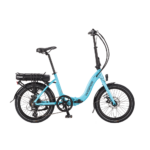Has anyone used these on E Bike?
NEW AMERITYRE AIRLESS FLAT FREE BICYCLE TYRE 26 X 1.95PAIR MOUNTAIN TREAD | eBay
gray
NEW AMERITYRE AIRLESS FLAT FREE BICYCLE TYRE 26 X 1.95PAIR MOUNTAIN TREAD | eBay
gray
Probably because of the amount force required to get the tyre on the rim. I bet it is a right wrestling match to get the tyre fitted.This review from 2005 says enough to put me off http://hex.meiring.org.uk/pdm/Audax/articles/Amerityre.html
I also note from the second photo on the eBay ad that they are for steel rims?
Exactly right. When Peter Eland of VeloVision reviewed a pair of these they were fitted by the supplier who, to Peter's alarm used two huge screwdrivers as tyre levers to force them onto the rim. Very risky with alloy rims.Probably because of the amount force required to get the tyre on the rim. I bet it is a right wrestling match to get the tyre fitted.





